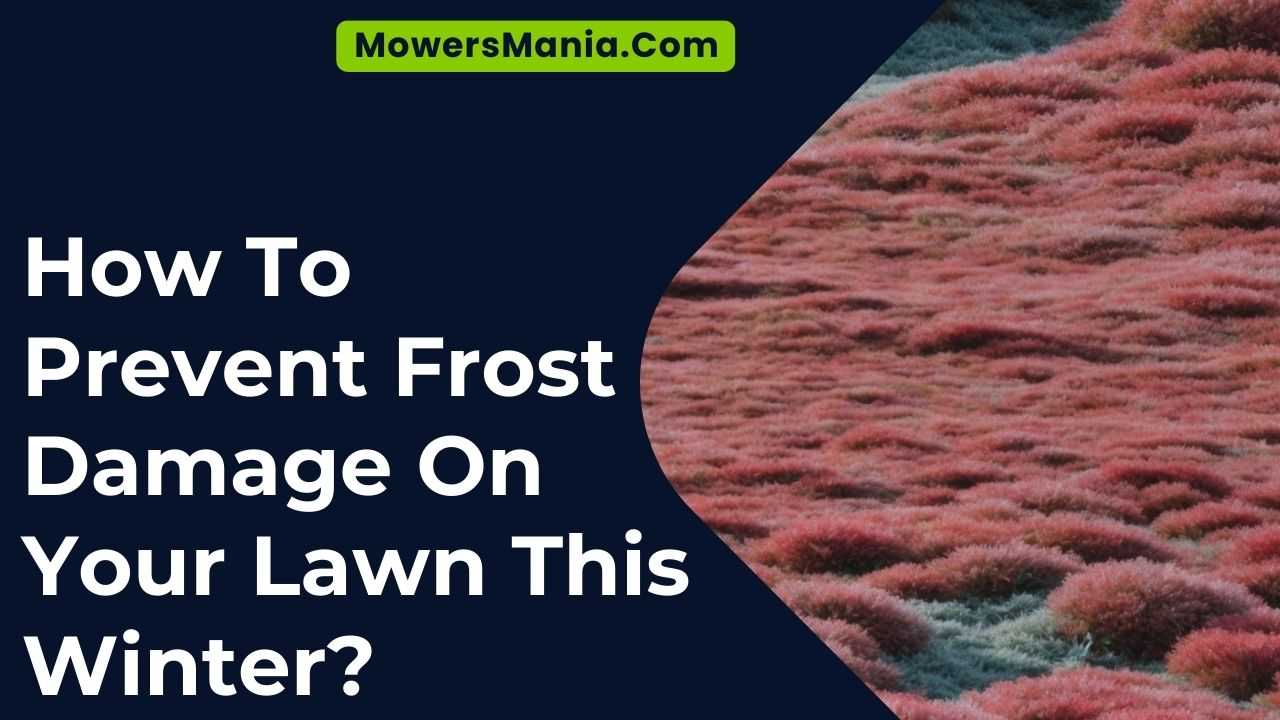Are you worried about the frost damaging your beautiful lawn this winter? Don’t fret! We’ve got you covered with some easy and effective tips to prevent frost damage.
By following proper watering techniques, adjusting your mowing practices, insulating your soil, and using protective covers, you can ensure that your lawn stays healthy and vibrant all season long.

Plus, we’ll share some additional tips to keep your lawn looking its best during the chilly months ahead.
Proper Watering Techniques
To prevent frost damage on your lawn this winter, prioritize the implementation of proper watering techniques. Watering your lawn correctly is essential in maintaining its health and resilience during the colder months.
When it comes to watering, it’s important to strike a balance between providing enough moisture for your grass to thrive while avoiding overwatering, which can lead to other problems such as root rot or fungal growth.
One key aspect of proper watering is to water deeply and infrequently. Instead of giving your lawn a shallow watering every day, focus on watering deeply once or twice a week. This allows the water to penetrate the soil and reach the roots, promoting deeper root growth and making your lawn more resistant to frost damage.
Another important consideration is the timing of your watering. It’s best to water your lawn in the morning, as this allows the grass to dry before evening temperatures drop. Watering in the evening can result in prolonged leaf wetness, which creates a favorable environment for frost formation.
Additionally, adjusting your watering schedule according to the weather conditions is crucial. During colder periods, when the ground is likely to freeze, it’s advisable to reduce the amount of water you provide to your lawn. This helps prevent excess moisture from freezing and causing damage to the grass.
Mowing Practices for Winter
You should adjust your mowing practices for winter to ensure the health and resilience of your lawn.
As the temperatures drop and the growth rate of your grass slows down, it’s important to make some changes to your mowing routine.
- First, raise the cutting height of your lawnmower. By leaving your grass a bit longer, around 2 to 3 inches, you can provide it with extra protection against the cold weather. Longer grass blades can help insulate the soil and the roots, reducing the risk of frost damage.
- Additionally, avoid cutting your grass too short, as this can weaken the lawn and make it more susceptible to winter stress.
- Another important aspect of winter mowing is to adjust the frequency of your mowing sessions. Since the grass growth slows down during this time, you can reduce the frequency of mowing. Instead of mowing every week, you can switch to mowing every two weeks or even once a month, depending on the rate of growth in your lawn.
- This will allow your grass to grow a bit longer and develop stronger roots, which will help it withstand the winter conditions.
- Lastly, remember to keep your lawnmower blades sharp. Dull blades can tear the grass instead of cutting it cleanly, which can lead to stress and damage. Sharpening your blades regularly will ensure a clean cut, minimizing stress on the grass and promoting a healthier lawn.
Insulating Your Soil

Adjusting your mowing practices for winter can help prevent frost damage on your lawn. One important aspect to consider is insulating your soil.
Insulating your soil is crucial because it helps protect the roots of your grass from extreme cold temperatures. When the temperature drops, the ground can freeze, causing damage to the roots and ultimately killing your grass.
To insulate your soil, start by adding a layer of mulch to your lawn. Mulch acts as a protective barrier, trapping heat and preventing the soil from freezing. Spread a layer of organic mulch, such as wood chips or straw, around your lawn, making sure to cover the entire area evenly.
Another effective method to insulate your soil is by using a winter cover crop. Planting a cover crop, such as winter rye or clover, helps retain heat in the soil and prevents freezing.
These crops also add organic matter to the soil, improving its fertility and overall health. Remember to remove the cover crop in the spring before it goes to seed to prevent it from becoming invasive.
Using Protective Covers
Protect your lawn from frost damage this winter by utilizing protective covers. When temperatures drop, it’s important to shield your grass and plants from the harsh elements.
Protective covers act as a barrier, preventing frost from forming on the surface and damaging the delicate vegetation underneath.
To help you choose the right protective cover for your lawn, here is a comparison table of the most commonly used materials:
| Material | Pros | Cons |
|---|---|---|
| Straw | Excellent insulation | Attracts pests |
| Burlap | Allows air and water circulation | Can be expensive |
| Plastic | Provides complete coverage | Traps moisture |
| Frost cloth | Lightweight and breathable | Requires proper anchoring |
| Newspapers | Affordable and readily available | Can blow away easily |
Consider the specific needs of your lawn and the climate in your area when selecting a protective cover. Remember to secure the covers properly to ensure they stay in place during windy conditions.
By taking this proactive step, you can safeguard your lawn from frost damage and enjoy a healthy, green landscape come springtime.
Additional Tips for Frost Prevention

To further protect your lawn from frost damage, it’s important to implement additional strategies and adjustments.
Here are some tips to help you prevent frost damage this winter:
- Proper watering: Make sure your lawn is well-hydrated before the first frost. Water deeply and infrequently to encourage strong root growth. Avoid watering in the evening, as this can increase the chances of frost damage.
- Mowing height: Keep your grass at a slightly taller height going into winter. Longer grass blades provide some insulation for the soil, protecting it from freezing temperatures.
- Fertilization: Apply a slow-release winter fertilizer in late fall. This will provide your lawn with the necessary nutrients to stay healthy during the cold winter months and promote strong root development.
- Avoid foot traffic: Try to minimize foot traffic on your lawn during frosty conditions. Walking on frozen grass can cause the blades to break and damage the overall health of your lawn.
Frequently Asked Questions [FAQs]
What Are the Common Signs of Frost Damage on a Lawn?
You may notice brown or wilted patches on your lawn after frost damage. The grass may be brittle and easily breakable. It’s important to take action to prevent further damage.
Can I Use a Regular Tarp or Plastic Sheet as a Protective Cover for My Lawn During Winter?
Yes, you can use a regular tarp or plastic sheet as a protective cover for your lawn during winter. It will help prevent frost damage and keep your lawn safe from the cold temperatures.
How Often Should I Water My Lawn During Winter to Prevent Frost Damage?
You should water your lawn sparingly during winter to prevent frost damage. Overwatering can lead to frozen roots and increase the risk of damage. Be mindful of the moisture levels and adjust accordingly.
Are There Any Specific Types of Grass or Lawn Care Products That Are More Resistant to Frost Damage?
There are specific types of grass and lawn care products that can be more resistant to frost damage. These options can help protect your lawn during the winter months.
Can I Use Mulch to Help Insulate the Soil and Prevent Frost Damage?
Yes, you can use mulch to help insulate the soil and prevent frost damage. It acts as a protective layer, trapping heat and preventing the soil from freezing too deeply.
Conclusion
So remember, by implementing proper watering techniques, adjusting your mowing practices, insulating your soil, and using protective covers, you can effectively prevent frost damage on your lawn this winter.
Don’t forget to follow these additional tips for extra protection.
With a little effort, you can keep your lawn healthy and green throughout the colder months.
Don’t let frost get in the way of a beautiful lawn!



